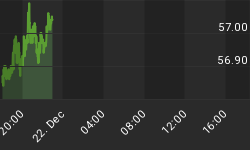Copper is one metal that could be called a barometer of the economy. It is used in every business around the world in one way or another. Because of its wide spread use, it is often referred to as Dr. Copper. The reason of course, is that when economic activity is healthy or weak, demand for the metal reflects it. At this point in time it can not be argued that demand is very high. From a price per pound standpoint, it has never been in such great demand. The long term chart below shows us this with clarity.

Copper will often begin to rise and fall in both price and stockpile supply months before the economy shows strength and weakness. Since 1970 there have been 4 major price increases in copper. Obviously the two tops shown in the above chart ended in the $1.50 - $1.75 range. The other two tops (not shown) in 1974 and 1980 were similar in price, ending at $1.33 and $1.48 respectively.
The rise in prices from the trough low occurring in November 2001 seemed quite typical until they rose to a historic high in August 2005. Even at that point there was no cause for alarm because China and India were growing very quickly. As prices approached $2.00, Commentator after Commentator became bearish the price of copper and as prices continued higher, many sought to explain their early calls to sell. My favorite is the one that claims China has been building huge inventories so they can crash the market when they dump a gazillion tons of copper into the market. This is to be done in response to producers charging them such high prices over the past couple of years. China wants some payback for getting ripped off so they will crash the price. Sounds like a plan to me. The problem is, that after they dump (say ½ a gazillion tons) on the market, the other ½ a gazillion tons they have left has no place to be sold and it's worth a lot less money. After hearing this story, I decided to run my MPC (Market Participation Calculator) for the copper market.
It turns out that a change in the market had occurred many months in advance of a new high in copper prices. Since the MPC is a proprietary method of gauging activity within a given market we won't go into detail, but basically what we see since February 2005, it that the copper market is crowded. Usually, crowded commodities markets clear out within a couple months but in this case, the trend is over 12 months. This is confirmation that the rise in prices from $1.60 is not supply and demand based, but rather pure speculation on the part of a huge amount of Trend Chasers.
Along with the MPC, the long term chart its self tells a story of disaster on the horizon. The spike in prices is a 372% gain from the low which is a very unusual gain for any commodity in such a short period of time. Elliott Wave Theory also points to a huge sell off in prices ahead.
The disaster I refer to will involve those Trend Chasers that are caught at the ultimate top of the market. They will not be able to get out fast enough to avoid the huge fall in prices that will occur. My MPC suggests that $2 -3 billion dollars will be lost in the first leg down. We as a larger group will have to hope that the ultimate top does not signal an economic disaster that commonly occurs shortly after a falling copper price, a recession.
The pattern you see in the above chart is a terminal one, you will not find a similar pattern anywhere in chart land that did not (in the end) crash all the way back (or very nearly) to it's humble beginnings. Conclusion, copper is a scale in sell.
Zorro
The above information was released to my Subscribers on 02/04/06. With copper down nearly 10 cents per pound in the active contract over the past week, the information provided could be viewed as having some value.
It may be of some interest to those reading this that I do not sell investment advice, I do however sell information. Perhaps you might be interested in this week's commentary concerning the copper market. If so, you can follow the link to dowtheoryproject.com and subscribe for a very small fee.
I tell you what; as an added incentive I'll put my MPC to work in the gold market this weekend and have a report ready for you by Sunday night.
Best Regards, Z
Comments? info@dowtheoryproject.com















